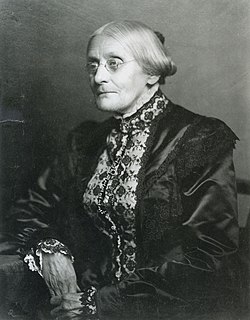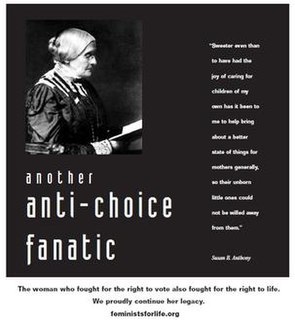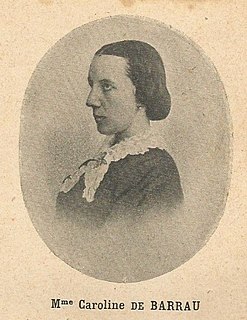Related Research Articles

Susan B. Anthony was an American social reformer and women's rights activist who played a pivotal role in the women's suffrage movement. Born into a Quaker family committed to social equality, she collected anti-slavery petitions at the age of 17. In 1856, she became the New York state agent for the American Anti-Slavery Society.

Elizabeth Cady Stanton was an American writer and activist who was a leader of the women's rights movement in the U.S. during the mid- to late-19th century. She was the main force behind the 1848 Seneca Falls Convention, the first convention to be called for the sole purpose of discussing women's rights, and was the primary author of its Declaration of Sentiments. Her demand for women's right to vote generated a controversy at the convention but quickly became a central tenet of the women's movement. She was also active in other social reform activities, especially abolitionism.

The National Woman Suffrage Association (NWSA) was formed on May 15, 1869, to work for women's suffrage in the United States. Its main leaders were Susan B. Anthony and Elizabeth Cady Stanton. It was created after the women's rights movement split over the proposed Fifteenth Amendment to the U. S. Constitution, which would in effect extend voting rights to black men. One wing of the movement supported the amendment while the other, the wing that formed the NWSA, opposed it, insisting that voting rights be extended to all women and all African Americans at the same time.

The Women's Loyal National League, also known as the Woman's National Loyal League and other variations of that name, was formed on May 14, 1863, to campaign for an amendment to the U.S. Constitution that would abolish slavery. It was organized by Elizabeth Cady Stanton, its president, and Susan B. Anthony, its secretary. In the largest petition drive in the nation's history up to that time, the League collected nearly 400,000 signatures on petitions to abolish slavery and presented them to Congress. Its petition drive significantly assisted the passage of the Thirteenth Amendment, which ended slavery in the U.S. The League disbanded in August 1864 after it became clear that the amendment would be approved.
The American Woman Suffrage Association (AWSA) was a single-issue national organization formed in 1869 to work for women's suffrage in the United States. The AWSA lobbied state governments to enact laws granting or expanding women's right to vote in the United States. Lucy Stone, its most prominent leader, began publishing a newspaper in 1870 called the Woman's Journal. It was designed as the voice of the AWSA, and it eventually became a voice of the women's movement as a whole.
Levi Starr Chatfield was an American lawyer and politician.

The American Equal Rights Association (AERA) was formed in 1866 in the United States. According to its constitution, its purpose was "to secure Equal Rights to all American citizens, especially the right of suffrage, irrespective of race, color or sex." Some of the more prominent reform activists of that time were members, including women and men, blacks and whites.
Ann Dexter Gordon is an American research professor in the department of history at Rutgers University and editor of the papers of Elizabeth Cady Stanton and Susan B. Anthony, a survey of more than 14,000 papers relating to the pair of 19th century women's rights activists. She is also the editor of the multi-volume work, Selected Papers of Elizabeth Cady Stanton and Susan B. Anthony, and has authored a number of other books about the history of the women's suffrage movement. She worked with popular historian Ken Burns on his 1999 book and appears in his documentary film about Stanton and Anthony. Since 2006, Gordon has repeatedly weighed in on the Susan B. Anthony abortion dispute stating that "Anthony spent no time on the politics of abortion. It was of no interest to her."

Susan B. Anthony was a leader of the American women's suffrage movement whose position on abortion has been the subject of a modern-day dispute. The dispute has primarily been between anti-abortion activists, who say that Anthony expressed opposition to abortion, and acknowledged authorities in her life and work who say that she did not.
Hester Vaughn, or Vaughan, was a domestic servant in Philadelphia who was arrested in 1868 on a charge of killing her newborn infant, and was sentenced to hang after being convicted of infanticide. The Revolution, a women's rights newspaper established by Susan B. Anthony and Elizabeth Cady Stanton, conducted a campaign to win her release from prison. The Working Women's Association, an organization that was formed in the offices of The Revolution, organized a mass meeting in New York City in her defense. Eventually Vaughn was pardoned by the governor of Pennsylvania, and deported back to her native England.

Ellis Meredith (1865–1955) was an American suffragist, journalist, and novelist, known as the Susan B. Anthony of Colorado.
History of Woman Suffrage is a book that was produced by Elizabeth Cady Stanton, Susan B. Anthony, Matilda Joslyn Gage and Ida Husted Harper. Published in six volumes from 1881 to 1922, it is a history of the women's suffrage movement, primarily in the United States. Its more than 5700 pages are the major source for primary documentation about the women's suffrage movement from its beginnings through the ratification of the Nineteenth Amendment to the U.S. Constitution, which enfranchised women in the U.S. in 1920. Written from the viewpoint of the wing of the movement led by Stanton and Anthony, its coverage of rival groups and individuals is limited.

Caroline de Barrau (1828–88) was a wealthy French educationalist, feminist, author and philanthropist. She became interested in the education of girls, created a school in Paris where her daughter was taught, and encouraged her daughter and other young women to successfully apply for admission to the University of Paris, previously a male-only institution. She belonged to international feminist associations, investigated the conditions of working women in Paris, was a leader in the campaign to eliminate state-regulated prostitution, helped prostitutes reenter society after being released from prison and provided aid to abandoned infants. She was the author of several books on women's issues.
The Georgia Woman Suffrage Association was the first women's suffrage organization in the U.S. state of Georgia. It was founded in 1890 by Helen Augusta Howard (1865-1934). It was affiliated with the National American Woman Suffrage Association (NAWSA).

Ellen Martin Henrotin was a wealthy American society matron, labor reform activist, club leader and social reformer affiliated with social welfare and suffrage movements.
The Ohio Women's Convention at Salem in 1850 met on April 19–20, 1850 in Salem, Ohio, a center for reform activity. It was the third in a series of women's rights conventions that began with the Seneca Falls Convention of 1848. It was the first of these conventions to be organized on a statewide basis. About five hundred people attended. All of the convention's officers were women. Men were not allowed to vote, sit on the platform or speak during the convention. The convention sent a memorial to the convention that was preparing a new Ohio state constitution, asking it to provide for women's right to vote.
Charlotte Bolles Anthony, also known as Lottie B. Anthony, was an American women's rights activist and suffragist. Anthony was one of 14 women arrested with Susan B. Anthony after they illegally voted in Rochester, N.Y. on November 5, 1872.

Mary Tenney Gray was a 19th-century American editorial writer, clubwoman, philanthropist, and suffragist from Pennsylvania, who later became a resident of Kansas. She lived in Kansas City, Kansas for more than twenty years and during that time, was identified with almost every woman's movement. She served on the editorial staff of several publications including the New York Teacher, the Leavenworth Home Record, and the Kansas Farmer. Gray's paper on "Women and Kansas City's Development" was awarded the first prize in the competition held by the Women's Auxiliary to the Manufacturers' Association of Kansas City, Missouri.

Lucy Elmina Anthony was an internationally known leader in the American woman's suffrage movement. She was the niece of American social reformer and women's rights activist, Susan B. Anthony, and longtime companion of women's suffrage leader, Anna Howard Shaw. She served as a secretary to both women, as well as on the committee on local arrangements for the National Woman Suffrage Association (NWSA)

Laura M. Johns was an American suffragist and journalist. She served as president of the Kansas State Suffrage Association six times, and her great work was the arrangement of thirty conventions beginning in Kansas City in February, 1892. She also served as president of the Kansas Republican Woman's Association, superintendent of the Kansas Woman's Christian Temperance Union, and field organizer of the National American Woman Suffrage Association (NAWSA). Johns died in 1935.
References
- ↑ "Documentary Editing: What Is It and Why Is It Needed?". Cady Stanton and Susan B. Anthony Papers project. July 2009. Retrieved March 17, 2014.
- ↑ Dudden, Faye E. (2011). Fighting Chance: The Struggle over Woman Suffrage and Black Suffrage in Reconstruction America. New York: Oxford University Press. p. 203, footnote 28. ISBN 978-0-19-977263-6.
- ↑ "Making It Happen" by Ann D. Gordon in "Project News: Papers of Elizabeth Cady Stanton and Susan B. Anthony," Fall 2012, p. 5. Retrieved March 17, 2014.
- ↑ Ward, Geoffrey C. (1999). "A Note about Contributors". Not for Ourselves Alone: The Story of Elizabeth Cady Stanton and Susan B. Anthony . New York: Alfred Knopf. p. 241. ISBN 0-375-40560-7.